
This is a brief but comprehensive book covering the set of EMC skills that EMC practitioners today require in order to be successful in high-speed, digitalelectronics. The basic skills in the book are new and werent studied in mostcurricula some ten years ago. The rapidly changing digital technology has created this demand for a discussion of new analysis skills particularly for theanalysis of transmission lines where the conductors that interconnect the electronic modules have become electrically large, longer than a tenth of a wavelength, which are increasingly becoming important. Crosstalk between the linesis also rapidly becoming a significant problem in getting modern electronic systems to work satisfactorily. Hence this text concentrates on the modeling of electrically large connection conductors where previously-used Kirchhoffs voltage and current laws and lumped-circuit modeling have become obsolete because of the increasing speeds of modern digital systems. This has caused an increased emphasis on Signal Integrity. Until as recently as some ten years ago, digital system clock speeds and data rates were in the hundreds of megahertz (MHz) range. Prior to that time, the lands on printed circuit boards (PCBs) that interconnect the electronic modules had little or no impact on the proper functioning of those electronic circuits. Today, the clock and data speeds havemoved into the low gigahertz (GHz) range. INDICE: Chapter 1. Transmission Lines: Physical Dimensions vs. Electrical Dimensions. 1.1 Waves, Times Delay, Phase Shift, Wavelength, and Electrical Dimensions. 1.2 Spectral (Frequency) Content of Digital Waveforms and their Bandwidths. 1.3 The Basic Transmission Line Problem. Chapter 2. Time-Domain Analysis of Two-Conductor Lines. 2.1 The Transverse ElectroMagnetic (TEM) Mode of Propagation and the Transmission-Line Equations. 2.2 The Per-Unit-Length Paramaters. 2.3 The General Solutions for the Line Voltage and Current. 2.4 Wave Tracing and Reflection Coefficients. 2.5 A Simple Alternative to Wave Tracing in the Solution of Transmissions Lines. 2.6 The SPICE (PSPICE) Exact Transmission-Line Model. 2.7 Lumped-Circuit Approximate Models of the Line. 2.8 Effects of Reactive Terminations on Terminal Waveforms. 2.9 Matching Schemes for Signal Integrity. 2.10 Effect of Line Discontinuities. 2.11 Driving Multiple Lines. Chapter 3. Frequency-Domain Analysis of two-Conductor Lines. 3.1 The Transmission-Line Equations for Sinusoidal, steady-State (Phasor) Excitation of the Line.3.2 The General Solution for the Line Voltages and Currents. 3.3 The Voltage Reflection Coefficient and Input Impedance of the Line. 3.4 The Solution for the Terminal Voltages and Currents. 3.5 The SPICE Solution. 3.6 Voltage and Current as a Function of Position on the Line. 3.7 Matching and VSWR. 3.8 Power Flow on the Line. 3.9 Alternative Forms of the Results. 3.10 Construction of Microwave Circuit Components Using Transmission Lines. Chapter 4. Crosstalk in Three-Conductor Lines. 4.1 The Multiconductor Transmission Line (MTL) Equations. 4.2 The MTL Per-Unit-Length Parameters of Inductance and Capacitance. Chapter 5. The Approximate Inductive-Capacitive Crosstalk Model for Electrically-Short Lines. 5.1 The Inductive-Capacitive Coupling Approximate Model. 5.2 Separation of Crosstalk into Inductive and Capacitive Coupling Components. 5.3 Common-Impedance Coupling. 5.4 Effect of Shielded Wires in Reducing Crosstalk. 5.5 Effect of Shield Pigtails. 5.6 Multiple Shields. 5.7 Effect of Twisted Pairs ofWires in Reducing Crosstalk. 5.8 The Shielded, Twisted-Pair Wire; the Best ofBoth Worlds. Chapter 6. The Exact Crosstalk Prediction Model. 6.1 Decoupling the Transmission-Line Equations with Mode Transformations. 6.2 The SPICE Subcircuit Model. 6.3 Lumped-Circuit Approximate Models of the Line. 6.4 A Practical Crosstalk Problem. Appendix. A Brief Tutorial on Using PSPICE.
- ISBN: 978-1-118-14399-5
- Editorial: John Wiley & Sons
- Encuadernacion: Cartoné
- Páginas: 288
- Fecha Publicación: 18/11/2011
- Nº Volúmenes: 1
- Idioma: Inglés
